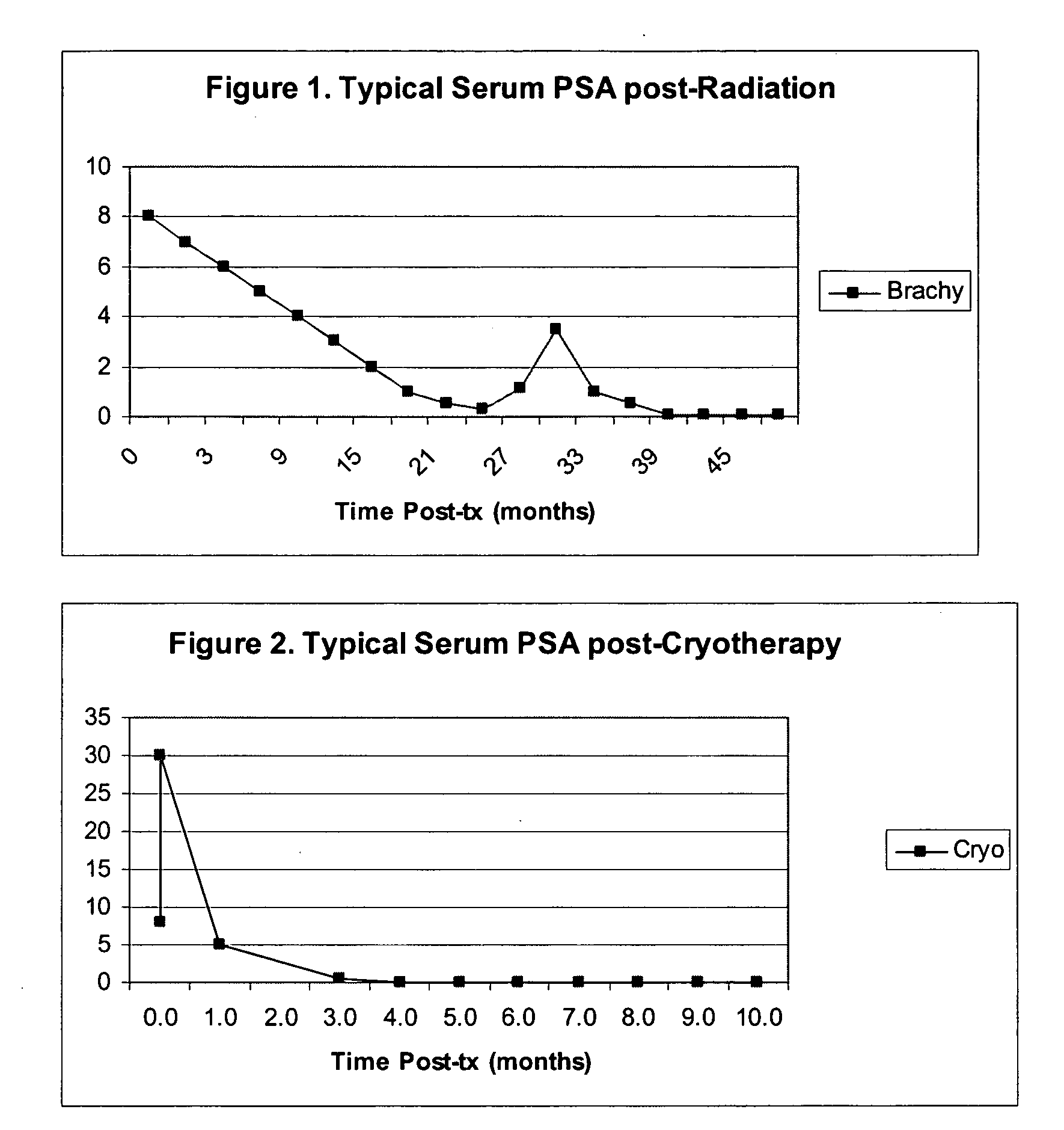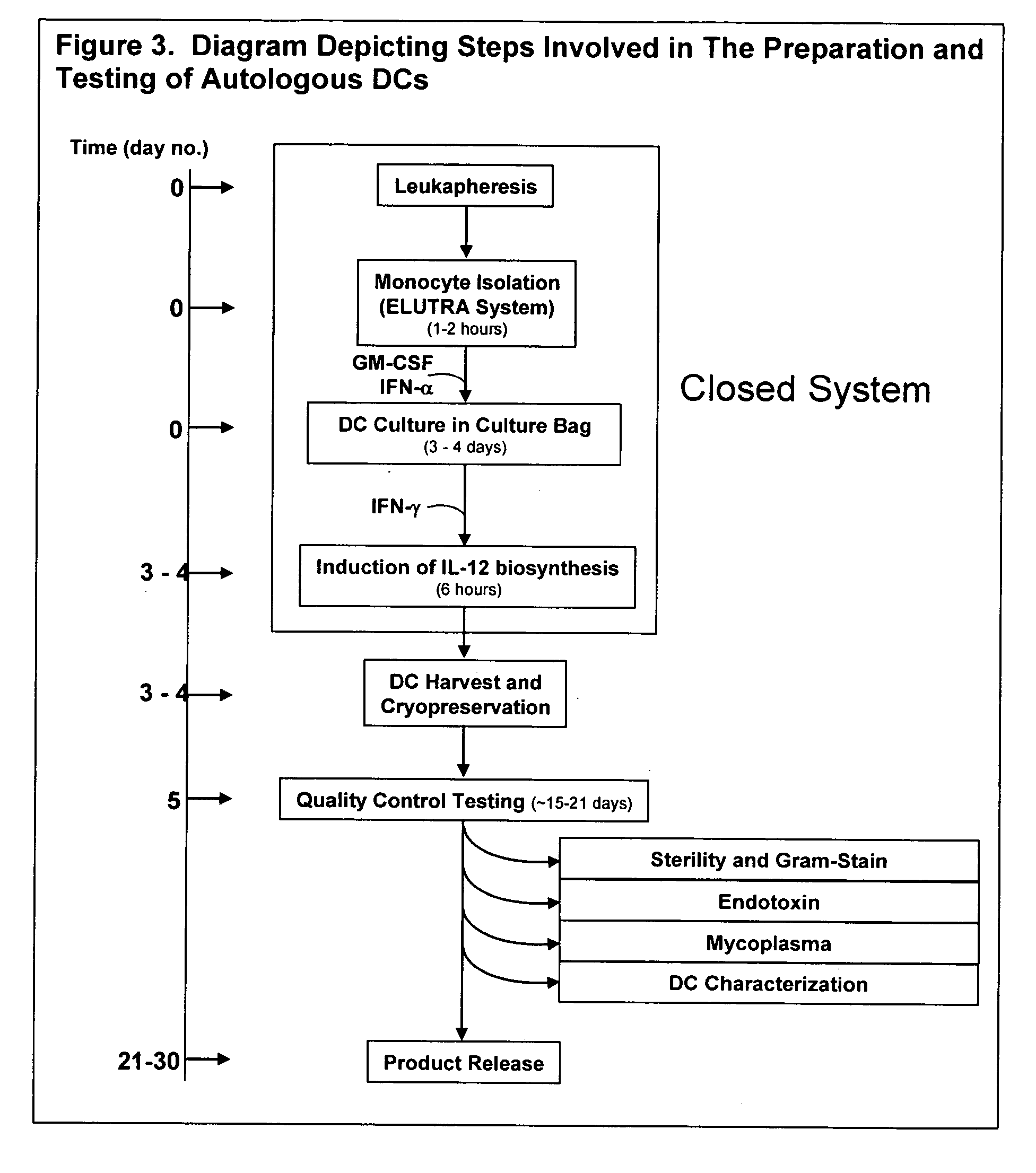Methods for treating tumors and cancerous tissues
a tumor and cancerous tissue technology, applied in the field of immunotherapy, can solve the problems of single antigens not being sufficient for tumor clearance, affecting the efficacy of tumor treatment, and poor candidates for immunotherapy for immunosuppression patients with high tumor burden, and achieve the effect of increasing the bioavailability of prostate specific antigens
- Summary
- Abstract
- Description
- Claims
- Application Information
AI Technical Summary
Benefits of technology
Problems solved by technology
Method used
Image
Examples
example 1
Production and Testing of Autologous Dendritic Cells
[0139]FIG. 3 is a flow diagram, illustrating the steps of the preparation and testing of autologous dendritic cells (DCs).
[0140] The production process of autologous DCs can be divided into 4 steps: (1) leukapheresis of patients, (2) isolation of DC (monocytes) using the Gambro ELUTRA™ system, (3) culture and maturation of DCs in a gas permeable bag, (4) harvest and cryopreservation of autologous DCs. Each of these steps is described below.
1. Leukapheresis of Patients
[0141] A single-stage White Blood Cell (WBC) Channel (or chamber) is used to collect the mononuclear cells. The anticoagulated whole blood enters the chamber through the inlet tubing. As it flows into the channel, it is separated into 3 blood components, the red blood cells (RBC), the WBCs, and the platelet-rich plasma. The separation of all 3 of these components is controlled by the specific gravity differences between the blood components and the pressure, densi...
example 2
Cryoablation and Intraprostatic DC Injection
[0152] The rationale for this protocol is based on the recognition that the liberation of tumor-associated antigen or prostate-associated antigen resultant from the cryoablation event allows the locally injected, autologous dendritic cells to uptake antigen, migrate to the lymphatic system, and affect a systemic immune response against tumor cells far removed from the prostate. Subtotal cryoablation (rather than total cryoablation) of the prostate is performed in order to allow for the creation of early necrotic prostatic tissue while minimizing the likelihood of freezing other, non-prostatic structures such as the neuro-vascular bundles, the anterior rectal wall, and other uninvolved bowel.
[0153] Immediately prior to the cryoablation procedure, four cryopreserved vials containing the patient's cultured dendritic cells are thawed to room temperature. The cell preparation should be thawed for a total of less than about 60 minutes prior to...
example 3
Treatment of Human Malignant Melanoma by Radiotherapy and Intratumoral Injection of DCs
[0164] Human malignant melanoma is often highly metastatic and radioresistant (Weichselbaum, et al., Proc. Natl. Acad. Sci. USA 82:4732-4735 (1985); Rubin, P. (1993) Clinical Oncology: A Multidisciplinary Approach for Physicians and Students 7Ed, Vol. 306 ,72 W. B. Saunders Philadelphia), however, ionizing radiation has shown therapeutic benefits. Ionizing radiation is a portion of the high energy electromagnetic radiation spectrum which can penetrate and be transmitted through tissues. A melanoma patient is subjected to ionizing radiation treatment, following standard protocol. The level of melanoma antigens, including Melan-A / MART-1, MAGE, NY-ESO-1, is monitored following irradiation. For a more detailed list of tumor antigens which may be additionally or alternatively monitored, see, e.g. Urban and Schreiber, Annu Rev. Immunol. 10:617-44 (1992), and Renkvist, et al., Cancer Immmunol. Immunothe...
PUM
| Property | Measurement | Unit |
|---|---|---|
| temperature | aaaaa | aaaaa |
| temperatures | aaaaa | aaaaa |
| temperatures | aaaaa | aaaaa |
Abstract
Description
Claims
Application Information
 Login to View More
Login to View More - R&D
- Intellectual Property
- Life Sciences
- Materials
- Tech Scout
- Unparalleled Data Quality
- Higher Quality Content
- 60% Fewer Hallucinations
Browse by: Latest US Patents, China's latest patents, Technical Efficacy Thesaurus, Application Domain, Technology Topic, Popular Technical Reports.
© 2025 PatSnap. All rights reserved.Legal|Privacy policy|Modern Slavery Act Transparency Statement|Sitemap|About US| Contact US: help@patsnap.com


